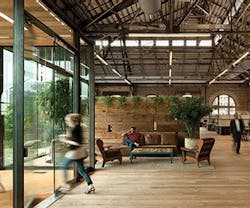I’m not much of a rule follower, and that’s what I love about interior design and the continued evolution of our practice: there are no rules! Yes, we must adhere to building codes and, of course, remain true to the principles of sustainability and accessibility, but as for design itself, there are few limits. I, for one, find great joy in the freedom that affords.
For me, pure joy is that “wow” moment at the completion of a project, when my clients see their space for the first time and realize that their ideas and dreams have come to fruition. I relish the occasions when a project goes beyond what the clients even imagined was possible, and they invite others to experience the space and share their excitement, their joy.
The desire to take a space to a higher level is one of the main reasons clients hire a designer. Merely meeting programmatic requirements is a given, and nearly anyone can do that (although not everyone does it well). It requires true skill and a willingness to take calculated risks to not only meet basic design goals, but also to draw out aspirations, to fully understand wants, and to push conceptual boundaries. Such exploration is one of the great joys of design, and it’s how we ultimately delight our clients.
The exciting thing about modern design is observing how this exploration, when coupled with a rigorous design process, reshapes and revitalizes our lives. Although my practice focuses primarily on the workplace, I’ve had the opportunity to design across project types with colleagues in my firm. In Minneapolis, where I have done much of my work, old mills and factories are being converted into restaurants, hotels, and offices. The bones of an old building can help set boundaries for the aesthetic, serving as design cues and allowing for the adaptive reuse of existing materials. Likewise, introducing modern materials into an old building can bring new life.
These days, though, it’s not just about blending old and new. Library design and classrooms are breaking with tradition as physical books give way to mobile devices and constant connectivity. New workplaces are borrowing elements from coffee shops and arcades to create community and a sense of play. Hospitals and hotels are blending elements of home. And, as I interact with emerging professionals in my firm and around the country, I can tell by the ways they work, shop, live, and play that this is just the beginning.
I recently had the opportunity to visit the Urban Outfitters corporate campus (designed by my firm, MSR) during Greenbuild in Philadelphia. It came as no surprise that the company’s space reflected its brand—functional, affordable, and beautiful—but I was struck by how much the offices resembled a design studio. Its open spaces and undefined, nontraditional meeting areas reminded me of my own workplace. There was a dynamic energy in the space, and I could sense that people were proud to work there.
My experience at Urban Outfitters fits with the increasing data that show good design has a positive effect on employee retention, recruitment, and productivity. These findings support what we all know to be true, but haven’t seen proven in actual research until recently. To further this work, the ASID Foundation recently granted more than $100,000 in funding to Cornell University and Michigan State University to analyze the effects of design in the workplace more closely. We hope to have research-supported findings to share soon.
In a similar vein, just before my trip to Philadelphia, I visited the Ace Hotel in New York. I had read about the lobby and seen pictures of the rooms, but nothing could have prepared me for the energy made possible by the design. Complete strangers were happily sitting next to people they didn’t know—some working, some socializing, some reading, or listening to music. The design of the hotel lobby creates an atmosphere that’s part think tank, part cocktail party, and yet, completely comfortable—it’s magical, and proves that great design truly brings joy to all.
Rachelle Schoessler Lynn, FASID, CID, LEED Fellow, is the national president of ASID and a senior associate with MSR in Minneapolis. ASID can be reached at (202) 546-3480 or [email protected], and on the web at asid.org.
